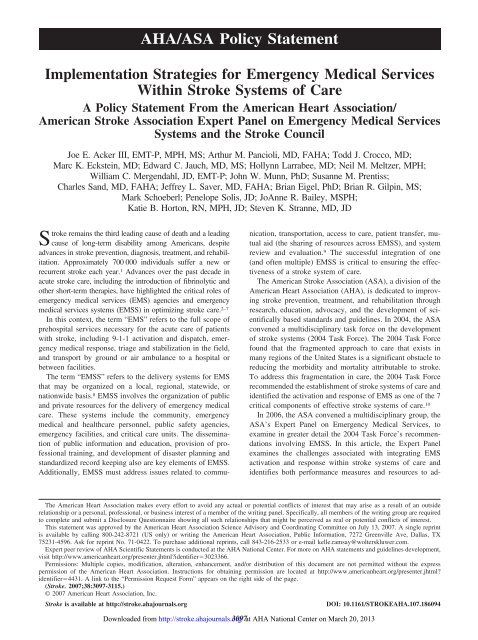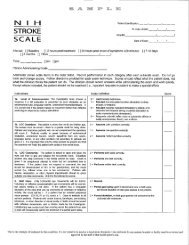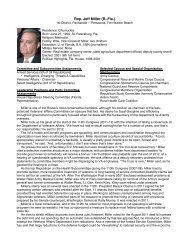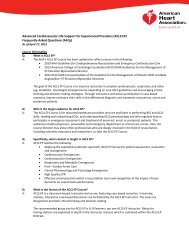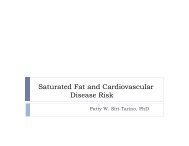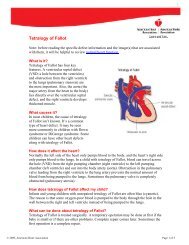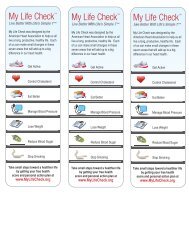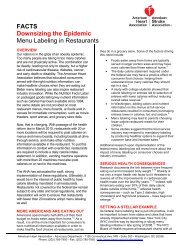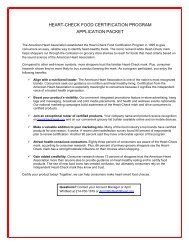2007 EMS Stroke Recommendations - American Heart Association
2007 EMS Stroke Recommendations - American Heart Association
2007 EMS Stroke Recommendations - American Heart Association
Create successful ePaper yourself
Turn your PDF publications into a flip-book with our unique Google optimized e-Paper software.
AHA/ASA Policy Statement<br />
Implementation Strategies for Emergency Medical Services<br />
Within <strong>Stroke</strong> Systems of Care<br />
A Policy Statement From the <strong>American</strong> <strong>Heart</strong> <strong>Association</strong>/<br />
<strong>American</strong> <strong>Stroke</strong> <strong>Association</strong> Expert Panel on Emergency Medical Services<br />
Systems and the <strong>Stroke</strong> Council<br />
Joe E. Acker III, EMT-P, MPH, MS; Arthur M. Pancioli, MD, FAHA; Todd J. Crocco, MD;<br />
Marc K. Eckstein, MD; Edward C. Jauch, MD, MS; Hollynn Larrabee, MD; Neil M. Meltzer, MPH;<br />
William C. Mergendahl, JD, EMT-P; John W. Munn, PhD; Susanne M. Prentiss;<br />
Charles Sand, MD, FAHA; Jeffrey L. Saver, MD, FAHA; Brian Eigel, PhD; Brian R. Gilpin, MS;<br />
Mark Schoeberl; Penelope Solis, JD; JoAnne R. Bailey, MSPH;<br />
Katie B. Horton, RN, MPH, JD; Steven K. Stranne, MD, JD<br />
<strong>Stroke</strong> remains the third leading cause of death and a leading<br />
cause of long-term disability among <strong>American</strong>s, despite<br />
advances in stroke prevention, diagnosis, treatment, and rehabilitation.<br />
Approximately 700 000 individuals suffer a new or<br />
recurrent stroke each year. 1 Advances over the past decade in<br />
acute stroke care, including the introduction of fibrinolytic and<br />
other short-term therapies, have highlighted the critical roles of<br />
emergency medical services (<strong>EMS</strong>) agencies and emergency<br />
medical services systems (<strong>EMS</strong>S) in optimizing stroke care. 2–7<br />
In this context, the term “<strong>EMS</strong>” refers to the full scope of<br />
prehospital services necessary for the acute care of patients<br />
with stroke, including 9-1-1 activation and dispatch, emergency<br />
medical response, triage and stabilization in the field,<br />
and transport by ground or air ambulance to a hospital or<br />
between facilities.<br />
The term “<strong>EMS</strong>S” refers to the delivery systems for <strong>EMS</strong><br />
that may be organized on a local, regional, statewide, or<br />
nationwide basis. 8 <strong>EMS</strong>S involves the organization of public<br />
and private resources for the delivery of emergency medical<br />
care. These systems include the community, emergency<br />
medical and healthcare personnel, public safety agencies,<br />
emergency facilities, and critical care units. The dissemination<br />
of public information and education, provision of professional<br />
training, and development of disaster planning and<br />
standardized record keeping also are key elements of <strong>EMS</strong>S.<br />
Additionally, <strong>EMS</strong>S must address issues related to communication,<br />
transportation, access to care, patient transfer, mutual<br />
aid (the sharing of resources across <strong>EMS</strong>S), and system<br />
review and evaluation. 9 The successful integration of one<br />
(and often multiple) <strong>EMS</strong>S is critical to ensuring the effectiveness<br />
of a stroke system of care.<br />
The <strong>American</strong> <strong>Stroke</strong> <strong>Association</strong> (ASA), a division of the<br />
<strong>American</strong> <strong>Heart</strong> <strong>Association</strong> (AHA), is dedicated to improving<br />
stroke prevention, treatment, and rehabilitation through<br />
research, education, advocacy, and the development of scientifically<br />
based standards and guidelines. In 2004, the ASA<br />
convened a multidisciplinary task force on the development<br />
of stroke systems (2004 Task Force). The 2004 Task Force<br />
found that the fragmented approach to care that exists in<br />
many regions of the United States is a significant obstacle to<br />
reducing the morbidity and mortality attributable to stroke.<br />
To address this fragmentation in care, the 2004 Task Force<br />
recommended the establishment of stroke systems of care and<br />
identified the activation and response of <strong>EMS</strong> as one of the 7<br />
critical components of effective stroke systems of care. 10<br />
In 2006, the ASA convened a multidisciplinary group, the<br />
ASA’s Expert Panel on Emergency Medical Services, to<br />
examine in greater detail the 2004 Task Force’s recommendations<br />
involving <strong>EMS</strong>S. In this article, the Expert Panel<br />
examines the challenges associated with integrating <strong>EMS</strong><br />
activation and response within stroke systems of care and<br />
identifies both performance measures and resources to ad-<br />
The <strong>American</strong> <strong>Heart</strong> <strong>Association</strong> makes every effort to avoid any actual or potential conflicts of interest that may arise as a result of an outside<br />
relationship or a personal, professional, or business interest of a member of the writing panel. Specifically, all members of the writing group are required<br />
to complete and submit a Disclosure Questionnaire showing all such relationships that might be perceived as real or potential conflicts of interest.<br />
This statement was approved by the <strong>American</strong> <strong>Heart</strong> <strong>Association</strong> Science Advisory and Coordinating Committee on July 13, <strong>2007</strong>. A single reprint<br />
is available by calling 800-242-8721 (US only) or writing the <strong>American</strong> <strong>Heart</strong> <strong>Association</strong>, Public Information, 7272 Greenville Ave, Dallas, TX<br />
75231-4596. Ask for reprint No. 71-0422. To purchase additional reprints, call 843-216-2533 or e-mail kelle.ramsay@wolterskluwer.com.<br />
Expert peer review of AHA Scientific Statements is conducted at the AHA National Center. For more on AHA statements and guidelines development,<br />
visit http://www.americanheart.org/presenter.jhtml?identifier3023366.<br />
Permissions: Multiple copies, modification, alteration, enhancement, and/or distribution of this document are not permitted without the express<br />
permission of the <strong>American</strong> <strong>Heart</strong> <strong>Association</strong>. Instructions for obtaining permission are located at http://www.americanheart.org/presenter.jhtml?<br />
identifier4431. A link to the “Permission Request Form” appears on the right side of the page.<br />
(<strong>Stroke</strong>. <strong>2007</strong>;38:3097-3115.)<br />
© <strong>2007</strong> <strong>American</strong> <strong>Heart</strong> <strong>Association</strong>, Inc.<br />
<strong>Stroke</strong> is available at http://stroke.ahajournals.org<br />
DOI: 10.1161/STROKEAHA.107.186094<br />
Downloaded from http://stroke.ahajournals.org/ 3097at AHA National Center on March 20, 2013


